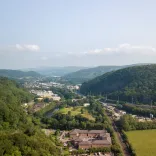Tell us a little about you and your Welsh Connections
As a native of the Rhondda Valleys in South Wales, I have travelled the depths and breadth of Wales, exploring all its beautiful locations, most of which lie under genuinely dark skies.
From North to South and East to West, there is always a great place to enjoy the night sky. However, my favourite locations lie in the heart of Wales. The hidden gems of Wales are undoubtedly the Cambrian Mountains and the Brecon Beacons, closely followed by the coastal regions of West Wales and the Llyn Peninsula.
In 2001 I studied science as a mature student at the Open University before joining the University of Glamorgan in South Wales on the newly formed Astronomy and Space undergraduate program. On completion of my degree with a first class honours and upon graduation, I was employed by the University to deliver its community based astronomy program.
In 2010 I took the decision to leave and establish two companies, Dark Sky Wales Education Services, a social enterprise that would provide Science, Technology, Engineering and Maths workshops to school age students across the country. The second company Dark Sky Wales Training Services would cover adult education and tourism.
What makes Wales one of the top countries for stargazing
The International Dark Sky Places (IDSP) initiative was founded by leading anti-light pollution body the International Dark Sky Association in 2001 to encourage communities to preserve and protect the world’s dark places through education and alternative lighting means. The association believes minimising light pollution is not only essential for the health of nocturnal wildlife, but also human wellbeing as well.
Wales has three IDSPs within its borders – including two of only 18 ‘International Dark Sky Reserves’ (the geographically largest categorisation of IDSP) worldwide.
Bannau Brycheiniog (Brecon Beacons) National Park was the first area to be given International Dark Sky Reserve status in Wales and only fifth in the world in 2013. The park stretches around 40 miles (64 km) from Abergavenny to Llandeilo across the eastern half of South Wales and makes a great viewing platform for watching constellations, the Mllky Way and even meteor showers.
Eryri (Snowdonia) National Park in North Wales was granted International Dark Sky Reserve status in 2015. Much of the park’s terrain, which covers around ten percent of the total land area of Wales,is rugged and mountainous, and largely uninhabited. As a result of this, the International Dark Sky Association considers Eryri one of the darkest places remaining in southern Britain.
Elan Valley in Mid Wales, is the only designated Dark Sky Park (a smaller version of a Dark Sky Reserve) in Wales. The park spans 70 square mile of the Elan Estate, which is owned by Dŵr Cymru - Welsh Water, and has a number of large reservoirs. The estate has long worked to protect wildlife in the area (with parts designated as special areas of conservation and scientific interest), but more recently has worked to preserve the area’s star-lit evening skies, taking precautions such as adapting street lamps to ensure minimal light pollution. As a result, the area now serves as a vast pocket of beautiful stargazing territory right in the middle of Wales
What is Dark Sky Wales Training and what does it offer the corporate market ?
Dark Sky Wales Training Services has worked closely with local authorities, National Landscapes formerly (AONB), National Trust, companies and the general public to assist them in developing a sensible approach to dark sky awareness.
Dark Sky Wales Training has developed its offer to include incentive and corporate experiences, providing bespoke stargazing offers to visitors from all over the world.
From bespoke stargazing nights in Bannau Brycheiniog (Brecon Beacons) National Park to inspirational talks by Apollo astronauts,we can help you create a truly memorable Business Event.








